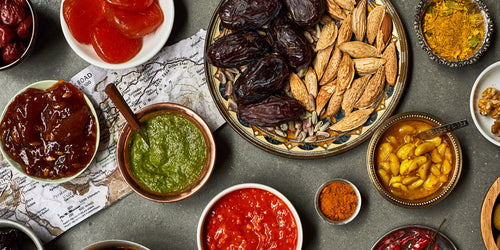Your Cart is Empty
First: it’s pronounced EYE-var, not ajj-var. Similar to the Turkish word ‘havyar,’ which means caviar. Many say ajvar derives its name from this Turkish word for the briny fish-egg delicacy, and the two foods share some commonalities. Like caviar, ajvar is luxurious in the mouth, opulent, even. It tastes the way rich feels.
This etymology is likely bunk; ajvar has much more in common with achar, a piquant condiment of South Asian origin. But the comparison has useful to show us just how valuable this roasted pepper spread is. Ajvar is a treasure of the Balkans, particularly the cuisines of Bosnia, Serbia, North Macedonia, and Romania. It goes by many names depending on who’s doing the naming and what’s added to the pot. Ajvar can taste mild and fruity or sharp and spicy. It might get a dose of chopped tomatoes or roast eggplant or even curds of farmer cheese. Though it’s made with oil, it’s mostly vegetable by mass, as healthy as a condiment could hope to be. But it’s also brilliant with meaty kebabs.
Ajvar contains multitudes, but this much is clear: we could all benefit from eating more of it. Here is a guide to start your journey.
What is ajvar?
Depending on the region and recipe, this family of spreads may be called ljutenica, pindjur, or zacusca, but whatever the name, ajvar begins with ripe red peppers harvested in the fall. Typically these are roga peppers, a Balkan variety similar to (but more flavorful) than common American bell peppers; rogas are elongated and come to a point at the end, hence their ‘horned pepper’ name.
Traditionally, the peppers are roasted over direct flame until their skins char and they collapse in on themselves, sweet and sticky; modern industrial ajvar producers often opt for less expensive oven baking methods that rob the peppers of a distinct smoky languor.
Once roasted, the peppers are seeded and skinned, then milled into a chunky paste. The purée is mixed with oil and stewed in large pots to drive off moisture and concentrate its flavor into a thick, ruby mash, which is then mixed with salt and maybe a touch of vinegar or lemon juice, and packed in jars and sealed for the year to come. There you have it: ajvar in its simplest form, as versatile as ketchup and tomato sauce combined.

Some ajvar makers use a mix of sweet rogas and spicy chiles, or go entirely with the hot stuff for a more fiery batch. (Jars of commercial ajvar usually label whether they’re mild or hot.) Roasted eggplant, cooked carrots, chopped or blended tomatoes, garlic, and onions are common additions. And the texture can range from a formless paste to a mash with distinct chunks. There’s no right or wrong here. All ajvar is good ajvar.
How to use ajvar
In the days before refrigeration, ajvar was an important part of the Balkan pantry to feed families through frigid winters. That preservation tradition still thrives today, even if it’s no longer necessary.
At the most basic, you can eat ajvar all on its own with a spoon as a cold chopped salad. Add it to a plate with some pickles, yogurt or feta, and bread, and you have a quick-and-delicious picnic lunch for one. Smoother versions are ideal for spreading on slices of sandwich bread or dolloping on toast points with a bit of warm brie. And if you want to get in the Bosnian spirit, serve ajvar as a side to grilled red meat. Steak or kebabs get the job done; though cevapi—little fingers of ground meat seasoned with salt and garlic, then wrapped in caul fat and seared over a wood fire—are the real deal.



You can also use ajvar as an ingredient for cooking. Its mild saltiness and rich texture make it a dump-and-stir sauce for pasta, or the base of a more complex one. Ajvar’s ripe red color makes a pot of risotto pop, and it adds bite and cohesion to grain or bean salads along with some crisp vegetables. You can even use it as a starter for a puréed and chilled soup, a kind of cheater’s gazpacho.
And how to store it
Wherever your ajvar inspiration takes you, store it in the fridge once you’ve opened a jar. Ajvar lacks the brine or salt concentration of pickles to keep it fresh after exposure to air, so try to eat through your jar within a week or two. You can also freeze ajvar, but like any food that contains fat, it should be wrapped tightly in plastic wrap and then a layer of aluminum foil to keep out unwanted freezer odors.
Explore Snuk’s collection of ajvar right this way.
Lead image by Franciop, CC BY-SA; pepper image by RÜŞTÜ BOZKUŞ







